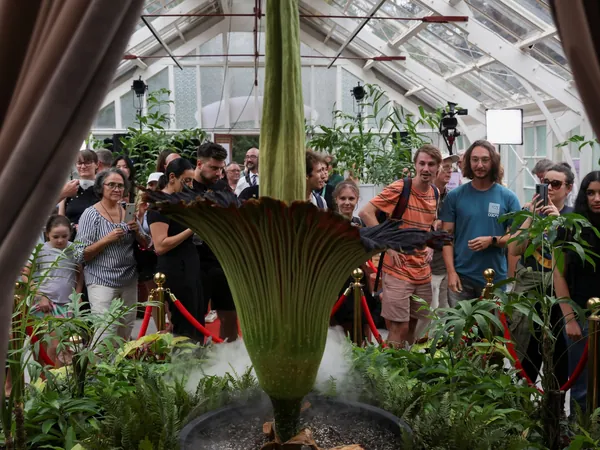
Meet 'Putricia': The Corpse Flower Drawing Thousands with Its Stench!
2025-01-24
Author: Wei
In a bizarre botanical phenomenon, the infamous 'Putricia,' a corpse flower, has captivated visitors at the Botanic Gardens of Sydney with its grotesque scent reminiscent of rotting flesh.
Known scientifically as *Amorphophallus titanum* and colloquially as the Titan Arum or "bunga bangkai" in Indonesia, this remarkable plant began to bloom on Thursday, generating an aromatic profile that many have compared to "dead rat."
The Botanic Gardens proudly hosts a collection of 11 corpse flowers, and staff lovingly dubbed this particular plant 'Putricia,' a playful blend of “putrid” and the name “Patricia.”
Over the past 18 days, a livestream documenting Putricia's growth from a small bud to an impressive 1.6 meters in height has racked up over 1.5 million views, creating a viral sensation online.
With an eager audience gathering both in person and virtually, director of horticulture John Siemon reported that 'at least 20,000' visitors have flocked to catch a whiff of Putricia, and many described the experience as both beautiful and nauseating.
One onlooker likened the aroma to a mix of 'hot garbage' and something more ungodly.
As the flower began to unfurl, its distinctive scent peaked on Thursday evening, wafting noticeable distances of up to 20 meters outside its pavilion.
Professor Brett Summerell, chief scientist at the Sydney Botanic Gardens, explains that the plant builds up its putrid perfume over time—by generating heat, it triggers chemical reactions meant to attract its primary pollinators: scavenging insects like flies and beetles.
Visually striking, the corpse flower boasts fluted crimson petals that can stretch beyond a meter wide, with a central stalk reaching heights of up to 3 meters.
This outrageous bloom is not just a feast for the senses; it serves a crucial function in the plant's reproduction.
However, this spectacle is fleeting—each bloom lasts only about a day, and with the last bloom at the Sydney Gardens occurring in 2010, Putricia makes her presence known as just the fifth corpse flower to flower here.
Once the flower's famed stalk collapses after approximately 48 hours, attendees will have to wait at least three to five years for another bloom.
As the Titan Arum is classified as endangered due to habitat loss and poaching, this moment is not only a botanical rarity but a chance to celebrate a species that could face extinction.
With an estimated 300 to 500 specimens remaining in the wild on the island of Sumatra, whether it’s the plant’s striking appearance or its putrid perfume that draws crowds, one thing is certain: Putricia has become a sensational star at the Sydney Botanic Gardens, reminding us of nature's wild and wonderful diversity!



 Brasil (PT)
Brasil (PT)
 Canada (EN)
Canada (EN)
 Chile (ES)
Chile (ES)
 Česko (CS)
Česko (CS)
 대한민국 (KO)
대한민국 (KO)
 España (ES)
España (ES)
 France (FR)
France (FR)
 Hong Kong (EN)
Hong Kong (EN)
 Italia (IT)
Italia (IT)
 日本 (JA)
日本 (JA)
 Magyarország (HU)
Magyarország (HU)
 Norge (NO)
Norge (NO)
 Polska (PL)
Polska (PL)
 Schweiz (DE)
Schweiz (DE)
 Singapore (EN)
Singapore (EN)
 Sverige (SV)
Sverige (SV)
 Suomi (FI)
Suomi (FI)
 Türkiye (TR)
Türkiye (TR)
 الإمارات العربية المتحدة (AR)
الإمارات العربية المتحدة (AR)